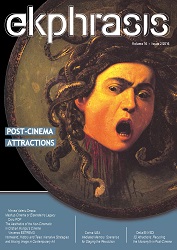The Aesthetics of the Non-Cinematic in Cristian Mungiu’s Cinema
The Aesthetics of the Non-Cinematic in Cristian Mungiu’s Cinema
Author(s): Doru PopSubject(s): Fine Arts / Performing Arts
Published by: Universitatea Babeş-Bolyai, Facultatea de Teatru si Televiziune
Keywords: post-cinema; non-cinematic; Cristian Mungiu; Bacalaureat
Summary/Abstract: This paper analyses the non-cinematic manifestations in Bacalaureat (2016), Cristian Mungiu’s most recent movie, at the narrative and visual levels. The author distinguishes between extra-cinematic, post-cinematic and non-cinematic and uses a couple definitions provided by Jacques Rancière in order to establish how the non- cinematic modes of representation in this movie are part of an aesthetics of the ineffable. The main argument is that Mungiu practices a type of non-cinematic cinema, one that takes place in the intervals between the cinematic sequences and in the silences of the frames. By comparing Bacalaureat (2016) with 4 luni, 3 săptămâni și 2 zile (2007), the other masterpiece of the Romanian director, the paper evaluates these movies by re-using Rancière’s concept of écart, or gap. For the author, the use of the extra-cinematic space and the non-cinematic treatment of scenes are the two main tools used by Mungiu to create a non-cinematic cinema takes place in the intervals, in the in-between-ness of the cinematic sequence, scenes and particular shots. Last but not least, the paper concludes that Bacalaureat is an expression of a “cinema which is not” , a type of movie-making that is not taking place exclusively on the screen of the theater room, nor in the reality of the film itself, but rather in the viewers mind.
Journal: Ekphrasis. Images, Cinema, Theory, Media
- Issue Year: 16/2016
- Issue No: 2
- Page Range: 8-24
- Page Count: 16
- Language: English

